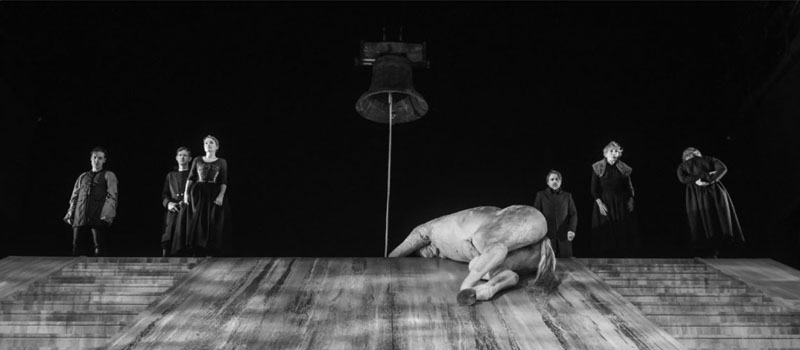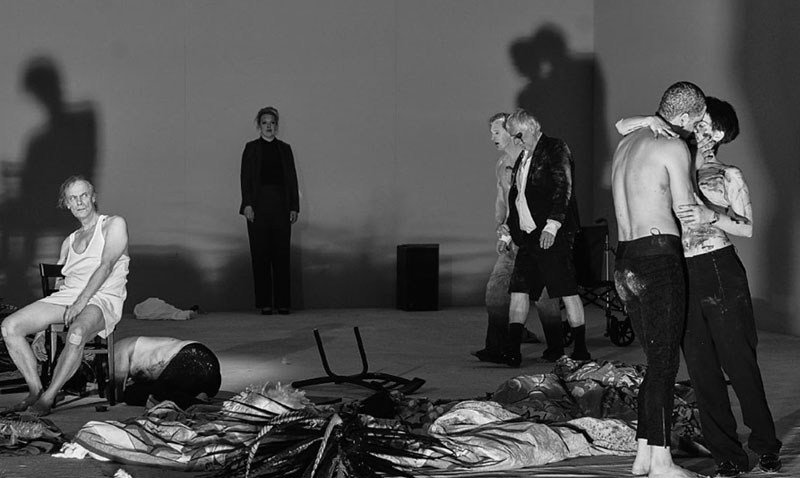“King Lear”: Thalia Theatre, Hamburg
Jakob Hingst in Hamburg at König Lear (Deutsches Schauspielhaus)
1 March 2019
A modern and contemporary production of Shakespeare’s King Lear inevitably faces the difficulty of time management. Fitting the five-act drama into the seemingly shortened attention span of contemporary society demands sometimes radical solutions. The production of König Lear at the Deutsches Schauspielhaus surely has gone in this direction. Its success, however, is perhaps dependant on one’s opinion of how Shakespearean classics should be produced nowadays. This production, directed by Karin Beier, certainly gives a distinct perspective on a play that is — as Jan Kott, the author of Shakespeare Our Contemporary, says — about the decay and ruin of the world.
Before the downfall starts and at the very beginning of the production, Lear (Edgar Selge) seemingly takes measure of his kingdom. Painstakingly, he walks along the three white walls of the stage. With a white ceiling and a slanted white floor, the play acquires the sense of a closed cosmos. Constant front-lights further throw shadows on the walls which, at times, act as hidden characters. The separation of Cordelia (Lina Beckmann) from her sisters, for example, is subtly underlined (or foreshadowed) by her shadow on the stage-left wall, while her sisters’ shadows occupy the central backwall.
Cutting Cordelia’s asides during the famous love test at the beginning of the play give her character less of a voice, which is, however, added to her sisters. Goneril (Carlo Ljubek) and Regan (Samuel Weiss) hypocritically and greedily compete in superlatives and a shouting-singing contest (featuring classics like ’Somewhere Over the Rainbow’ and ‘If You Don’t Know Me By Now’) that poignantly portrays the absurdity of Lear’s faith in their honesty.
In the ensuing chaos, Lear and everyone faithful to him and his admittedly outdated world-view is punished by Goneril, Reagan, or by Edmund (Sandra Gerling) who is the sisters’ counterpart in the subplot. Despite its notoriety, the Earl of Gloucester’s blinding still functions well to demonstrate in a chilling manner a height of cruelty and ruin. Neglecting the medical utensils that Oswald (Maximilian Scheidt) has purposely sterilised, Goneril works her high-heel into Gloucester’s eyes, as Regan bursts into haunting laughter that is only briefly interrupted by her vomiting.
Lear, in the meantime, descends further into madness. As not even his trusted Narr (Fool), brilliantly played by Lina Beckmann (whose Cordelia was — characteristically — less gripping), manages to give consolation, Lear’s descent is accelerated by Edgar, disguised as the naked madman armer Tom (Poor Tom).The tasteful, confident, and, more importantly, reasoned nudity of both Edgar and, eventually, Lear affords their scenes a suitable absurdity. The highlight is their attempts at philosophising while raging mad, which see them alternating between going back and forth, frantically running around, and sitting still in a pose suggestive of Rodin’s ”The Thinker” statue.

The ensemble. King Lear, Thalia Theatre, Hamburg. Photo credit: Krafft Angerer.
The devastation that Lear’s madness causes to his followers and particularly to his fool, is given effective expression by the Fool’s rendition of “What a Wonderful World” after the storm scenes. Starting with unsteady voice and unaccompanied, Lina Beckmann produces the second devastating moment of the production, as her melancholy and slow-paced song provides the audience with the opportunity to reflect on the madness they have just witnessed.
The casting decision to gender-swap the three primary antagonists Goneril, Regan, and Edmund seems somewhat uninspired. While Samuel Weiss, and particularly Carlo Ljubek, justify the decision with stellar performances in their roles, Sandra Gerling’s Edmund seems one-dimensional. The loud, obscene, aggressive dimension is expertly executed, but other nuances rarely find their way into her performance and so leaving Edmund to be perceived as little more than a stereotypically evil antagonist.
Similarly uninspired, albeit visually beautiful (which, however, shouldn’t be justification for a choice as politically controversial as this), are the costumes (by Johannes Schutz and Astrid Klein). For the second half, Goneril, Regan, and Edmund don Native American headdresses, and daub themselves with war-paint in preparation for the eventual showdown when Cordelia, having assembled an army in France, returns to her home country and seeks to right the wrongs of her sisters.

The ensemble. King Lear, Thalia Theatre, Hamburg. Photo credit: Krafft Angerer.
After presenting the increasing chaos of the first three acts for over two hours, however, the admittedly devastating resolution of the fourth and especially of the fifth act feels rushed, and thereby far less effective. In what seems like an abstracted battle scene, this production replaces the intricacies of Shakespeare’s skilful interweaving of all the plots. Among neatly choreographed movements of almost all the characters, a repetitive dance-like routine by Goneril, Regan, and Edmund stands out the most and lends a sense of aggression and chaos to the scene while adding passion and tension to their triangular relationship. One gets a clear sense of Goneril and Regan fighting for Edmund’s affection. ln the meantime, Lear, ignoring the chaos, slowly passes by each character, upon which they collapse dead.
Lear’s subsequent plea for Cordelia’s life over her dead body, and his own death in desperation shortly thereafter, are the only deaths that manage to evoke the emotions they warrant. Through extensive cutting in the second half, Shakespeare’s apocalyptic play loses significant emotional effectiveness. While this fits neatly with the production’s concept, such an approach to time management discards a lot of the almost defining overall features of the play and neglects part of the emotional potency that the play is known for. This results in a rare production of King Lear where one is more devastated at the intermission than at the end, something that is likely to disappoint devoted fans of Shakespearian tragedy.
Focusing on Lear’s world, madness and developing decay, rather than its results, however enables a perspective that puts an almost cautiously optimistic spin on a play about the world’s ruin. This is underlined by Edgar’s closing monologue, strikingly delivered while throwing white powder on all the corpses as a way of accepting and dealing with their deaths. As Poor Tom, he identifies chaos as a precondition of human life. By embracing the emptiness, the nothingness, that the play results in, he finds strangely, a bizarre form of optimism.









